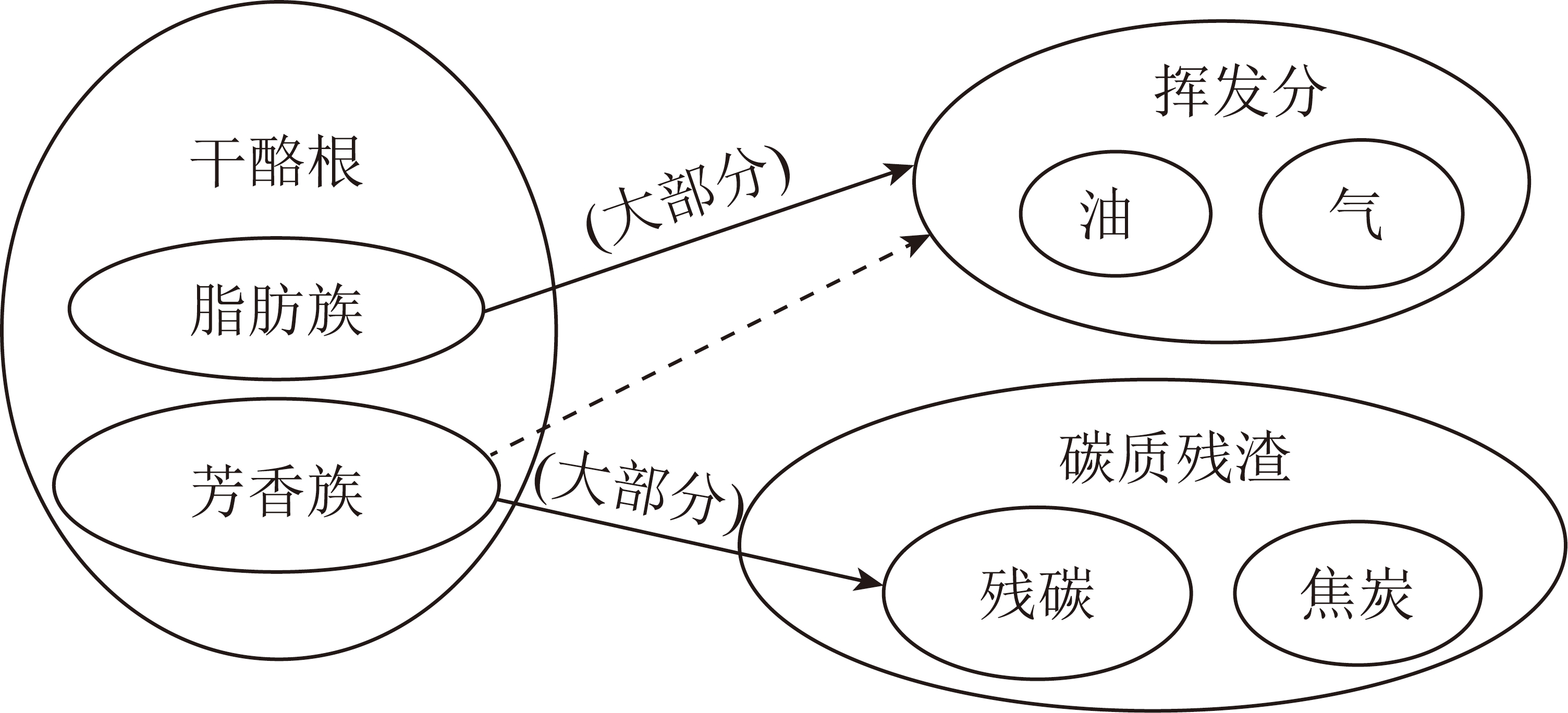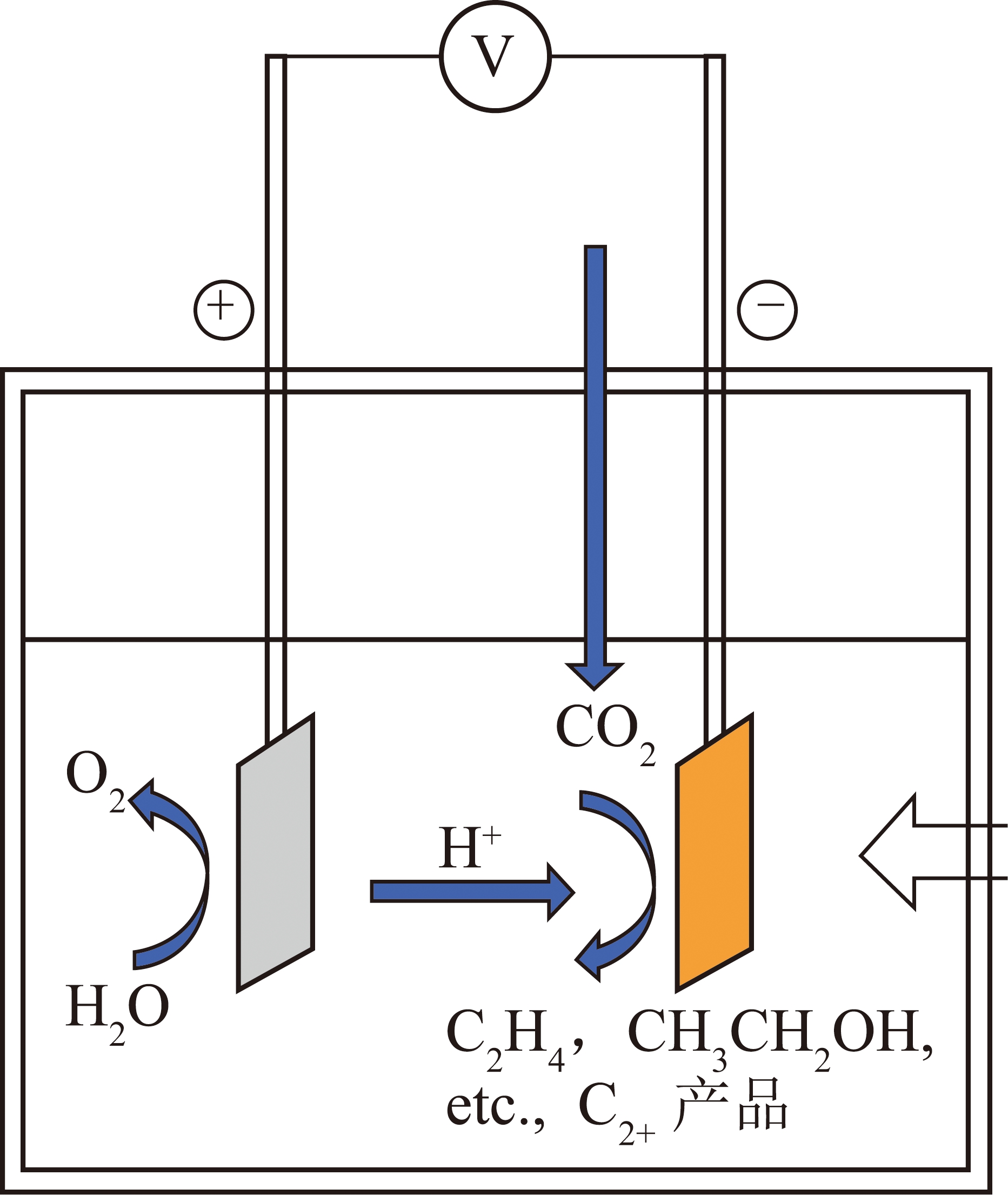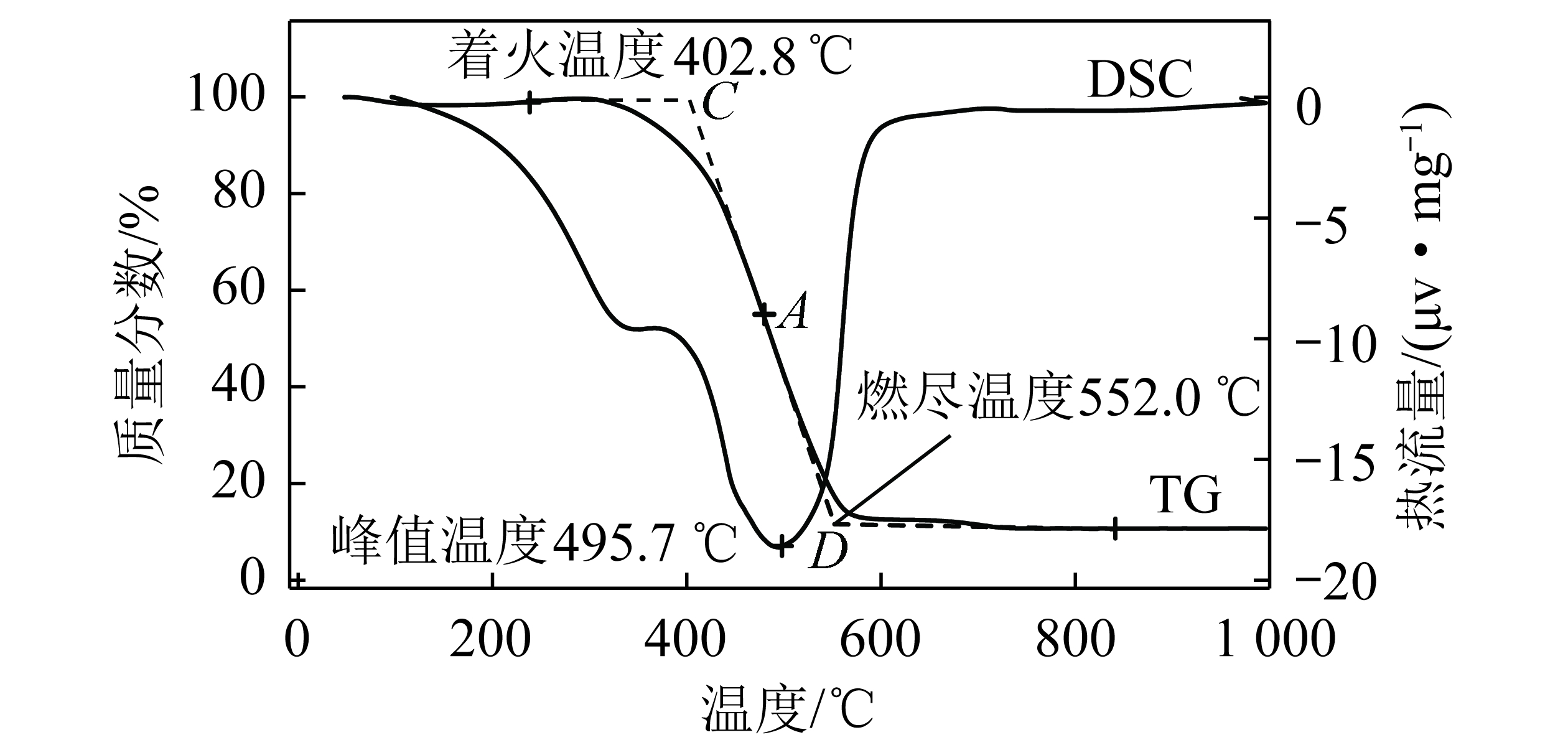研究论文
低温煤焦油沥青组分组成与结构分析
0 引 言
新疆低阶煤储量约占自治区煤炭总量的80%,其中,吐哈、和克两大基地的煤炭挥发分含量较高,吸引了多家企业通过分级分质转化实现煤炭的高值化利用,因而近年来其副产物煤焦油的产量增长较快[1]。在双碳背景下,低阶煤作为燃料的比例持续下降,而含碳资源的清洁高效转化是构建我国清洁低碳、安全高效的能源体系的必然选择[2-3],可以预见中低温煤焦油的产量将进一步增加。一般而言,此类焦油多采用固定床全加氢的方式,产品多为汽油和柴油[4-5]。然而煤焦油中含大量沥青,约占50%~60%[1,6-8],其成分极为复杂,富含胶质、沥青质等大分子物质,加氢过程中不仅能耗高且易聚集成焦[9],导致催化剂失活。因此,深入研究煤沥青的组成及结构对煤焦油加氢提质生产多元化产品具有重要意义。
关于沥青组成和结构研究,一般结合多种分析方法推测其缩合程度[10-12],获取元素的组成与分布等信息[13-14]。ILYIN等[15]以六甲基二硅氧烷为溶剂萃取重质原油中的沥青质,发现溶剂/油=15∶1(体积分数之比)时,沥青质的收率达到最大值38.7%,温度升高时,该沥青质具有黏弹性和可塑性,可用于生产碳纤维。KORNEEV等[16]采用逐步热分解法研究了初始组成和结构对重油沥青质热转化行为的影响,结果显示:沥青质中杂原子含量与油产率正相关,对气体产率影响为0。洪琨等[17]认为塔河常压渣油的饱和组分主要由链烷烃组成,芳香组分和胶质含有较多的3~4环芳香片,沥青质的芳环缩合程度更高,以5环为主。CHESHKOVA等[18]结果表明,Usa油田中重油的胶质组分由正构和支链烷烃、烷基环戊烷、烷基环己烷、单环和多环芳烃组成,硫和氮元素分别以硫桥和喹啉类存在,氧元素则以桥键和脂肪族醇、酯/醚基的形式存在。ZHU等[19]发现,与石油沥青质(P-asp)和(P-res)胶质相比,煤沥青质(C-asp)和胶质(C-res)富含—OH,其氢键类型主要为OH—OH和OH—O—C醚,二者的烷基侧链少且短,芳香环的取代度高,而P-asp和P-res的烷基支链化度更高。崔瀛丹等[6]选用无水乙醇、正戊烷、异丙醇、甲苯、四氢呋喃和 N-甲基吡咯烷酮萃取剂对中温煤沥青进行逐级萃取,发现随级数增加,各物质的芳香片层间距逐渐减小,芳香层片间直径、堆砌高度及芳香片层数逐渐增大。
上述研究多以石油沥青为原料[20-21],对煤沥青分子的结构解析相对较少,仍需深入探究[22-23]。因此,针对现有中低温煤焦油沥青含量高、组分复杂、全加氢提质过程中易结焦的问题,基于节能提效原则,首先依据SH/T 0509—2010《石油沥青四组分测定法》[24]对低温煤沥青进行四组分分离,然后解析各组分的元素组成与存在形式、相对分子量、环数分布、官能团结构等参数,基于此,推测各组分的三维结构,为此类沥青的分级转化提供理论依据。
1 试 验
1.1 试验原料
试验所用550 ℃煤热解产生的低温沥青(RP)取自于新疆哈密淖毛湖。依据GB/T 2291—2016《煤沥青实验室试样的制备方法》将原料粉碎研磨,过40目(0.40 mm)筛,于40 ℃下干燥1 h,置于干燥器中备用。煤沥青四组分分离过程如图1所示。

图1 煤沥青四组分分离的示意
Fig.1 Schematic diagram of four components separation of coal pitch
1.2 试验仪器与方法
采用德国Vario EL cube型元素分析仪测定样品中C、H、N和S元素含量。相对分子质量由美国安捷伦公司的Agilent-1100型凝胶渗透色谱仪测定,四氢呋喃(THF)为流动相,流速为0.6 mL/min,注射量为10 μL,柱温为40 ℃。采用岛津UV-2550型紫外-可见光光度计测定样品的芳环结构,参比液为甲苯,各组分浓度控制在10 mg/L内,扫描波长为250~500 nm。样品的官能团种类及含量由德国Bruker公司生产的VERTEX 70红外光谱仪测定,分辨率2.0 cm-1,扫描区间为4 000~400 cm-1。液体的H和C存在形式在室温条件下,以氘代氯仿(CDCl3)为溶剂,四甲基硅烷(TMS)为内标由Bruker 400M超导核磁共振仪测定。XPS 分析煤沥青各组分表面元素种类、含量及其化学形态。X射线源为单色器为Al Kα,功率为150 W。能量分析器采用CAE模式,内标:284.8 eV(C 1s)。
2 结果与讨论
2.1 组成与结构分析
2.1.1 元素分析
原料沥青RP经四组分分离后,饱和分Sa、芳香分Ar、胶质Re、沥青质As和残渣的收率分别为8.60%、8.40%、38.13%、16.94%和27.92%,其元素组成见表1。可见,Sa、Ar、Re和As的C、H含量和H/C依次递减,N、S和O含量与之相反,三者之和由5.15%增至15.57%,即杂原子更易富集于胶质和沥青质中。由于N与—OH之间能形成很强的氢键,是沥青质分子聚集沉积的重要作用力之一[25],故N和O含量高,意味着胶质和沥青质在加氢转化过程中易积碳。
表1 煤沥青各组分的元素组成及平均分子量
Table 1 Ultimate analysis and average molecule weight of the components in coal tar pitch

注:*为差减得到。
2.1.2 分子量和芳香环数分析
从分子量来看(图2(a)),Sa与Ar的分子量分布较集中;由表1可知,重均分子量(Mw)与数均分子量(Mn)比值pD较小,且峰强度高,推测二者的物质种类少,各物质相对含量高;沥青质组分的pD最大,峰值不明显,说明其分子量分布最宽,且物质种类丰富,各物质的相对含量均较低,无优势组分。同时,Ar的重均分子量分布最窄,As的分子量分布最宽,即分子量最大。

图2 煤沥青各组分的分子量分布和紫外光谱图
Fig.2 Molecular weight distribution and UV spectrum of the
components in coal tar pitch
由于芳香族化合物的紫外特征光谱峰较窄,且特征波长随芳环数增加而增加[26],因此对各组分进行紫外光扫描,结果如图2(b)所示。可见,除Sa外,其余组分在295和303 nm处有明显的特征吸收峰,可知三者均含3~4个环的渺位缩合芳香结构,即呈线性排列[27-28]。此外,Ar、Re和As吸收曲线有重叠,说明具有环数相同的芳香结构,然而含量存在差异;三者强度趋于0时的波长分别为420、493和651 nm,说明芳环数>5的化合物含量依次增加[26]。As的特征波长最宽,说明物质中芳环含量较多,分子量最大,这与GPC(图2(a))的结果相吻合。
2.1.3 官能团分析
紫外只能分析样品中芳环数量特征,且仅限于5环以内的芳烃[29-30],为分析样品中脂肪族分子结构及5环以上芳烃的结构特征,进一步采用红外进行分析,如图3所示。可知饱和分Sa、芳香分Ar、胶质Re和沥青质As,均出现了脂肪族—CH2不对称伸缩振动(2 922 cm-1)、脂肪族—CH3对称伸缩振动(2 840 cm-1)、脂肪族的—CH2与—CH3不对称变形振动(1 457 cm-1)和—CH2对称弯曲振动(1 376 cm-1)[31],其峰强度逐渐降低,说明前三者含有丰富的链烃或环烷烃[32]。此外,Sa于719 cm-1处出现了较弱的吸收峰,由n>4的—(CH2)n—的摇摆振动引起[33],表明饱和分中存在长链烃结构。Ar、Re和As均在3 100~3 000 cm-1出现了芳香C—H的伸缩振动吸收峰,其强度随组分缩合程度的增加而减弱,即As的强度最低,1 600 cm-1芳香C![]() C骨架伸缩振动峰与之趋势相反。就含氧基团而言,3 370、1 240 cm-1处属于醇类、酚类和醚类的C—O振动,Re的峰强度均低于As,说明前者酚羟基低于后者。与饱和分和芳香分相比,胶质和沥青质在1 706 cm-1有芳香族中酸酐C
C骨架伸缩振动峰与之趋势相反。就含氧基团而言,3 370、1 240 cm-1处属于醇类、酚类和醚类的C—O振动,Re的峰强度均低于As,说明前者酚羟基低于后者。与饱和分和芳香分相比,胶质和沥青质在1 706 cm-1有芳香族中酸酐C![]() O伸缩振动峰,这是由于C
O伸缩振动峰,这是由于C![]() O中氧的孤电子对极性强,易于在含有较高芳香苯环的胶质和沥青质富集[19]。
O中氧的孤电子对极性强,易于在含有较高芳香苯环的胶质和沥青质富集[19]。

图3 煤沥青各组分红外光谱图
Fig.3 FTIR spectra of the components in coal tar pitch
2.1.4 元素形态分布
采用X荧光光谱仪分析杂原子的分布形态并通过分峰拟合计算相对含量,分峰示意及结果分别见表2和图4。可见Sa、Ar、Re和As中碳主要以脂肪碳键(C—H、C—C)和芳香碳键(C![]() C)形式存在,而碳氧键含量较少,反映芳香性w(C—C)/(w(C—C) w(C
C)形式存在,而碳氧键含量较少,反映芳香性w(C—C)/(w(C—C) w(C![]() C))比值[34]分别为0、0.38、0.51和0.56。Sa、Ar、Re和As中C
C))比值[34]分别为0、0.38、0.51和0.56。Sa、Ar、Re和As中C![]() O的相对含量逐渐增加,而w(C—O)/(w(C—O—C) w(C—OH))下降,COO—含量均较低,主要因为C
O的相对含量逐渐增加,而w(C—O)/(w(C—O—C) w(C—OH))下降,COO—含量均较低,主要因为C![]() O中氧孤电子对与芳环共轭形成稳定结构,而沥青质中芳香环的含量高于胶质,因此前者的C
O中氧孤电子对与芳环共轭形成稳定结构,而沥青质中芳香环的含量高于胶质,因此前者的C![]() O含量更高[19,35]。此外,Sa、Ar和As中N的形态单一,Sa中N以氨基-N的形式存在,这是由于氨基主要存在于链烷烃上[36],后二者中则以N-6呈现;Re中吡啶-N(N-6)、氨基-N和吡咯-N(N-5)3种形态共存,其中N-5的比例高达55%,氨基-N存在可能与胶质侧链长有关[37]。就(w(N-5) w(N-6))/w(N)而言,Re、Ar和As比值分别为0.71、1.00和1.00,表明含氮基团主要/全部以不饱和氮环镶嵌在芳香层中[37]。饱和分和芳香分中S的各类形式均未被检出,与表1中S含量不符,这是由于XPS只能检测到样品表面的元素形态[38],加之各形态相对分散所致。Re和As中,S以硫砜和硫酸酯2种形态为主,质量分数之和高于75%。
O含量更高[19,35]。此外,Sa、Ar和As中N的形态单一,Sa中N以氨基-N的形式存在,这是由于氨基主要存在于链烷烃上[36],后二者中则以N-6呈现;Re中吡啶-N(N-6)、氨基-N和吡咯-N(N-5)3种形态共存,其中N-5的比例高达55%,氨基-N存在可能与胶质侧链长有关[37]。就(w(N-5) w(N-6))/w(N)而言,Re、Ar和As比值分别为0.71、1.00和1.00,表明含氮基团主要/全部以不饱和氮环镶嵌在芳香层中[37]。饱和分和芳香分中S的各类形式均未被检出,与表1中S含量不符,这是由于XPS只能检测到样品表面的元素形态[38],加之各形态相对分散所致。Re和As中,S以硫砜和硫酸酯2种形态为主,质量分数之和高于75%。
表2 各组分中 C、O、N、S 的不同形态及质量分数
Table 2 Forms and the corresponding relative content of C, O, N, S of the components


图4 不同元素的XPS分峰拟合曲线
Fig.4 XPS fitting spectra of different elements
2.2 结构参数计算与模型预测
为进一步确定沥青各组分氢和碳的存在形式,对样品进行1H-NMR和13C-NMR测定,积分结果分别见表3和4。由表3可知,Sa、Ar、Re和As中Hγ质量分数分别为23.57%、11.49%、16.57%和6.91%,表明胶质的长链烃或非对称饱和环烷烃的量高于芳香分;δH在1.0~1.9的峰归属芳环β位及远离β位的CH2或CH3上的氢(Hβ),Sa、Ar、Re和As中Hβ质量分数逐渐减小,分别为70.83%、48.59%、37.13%和29.91%,说明芳氢被脂基/环烷基取代的位置减少,各组分缩合程度逐渐增加;δH在6.0~7.2与单环芳氢归属区域(HA1),Sa、Ar、Re和As中HA1含量依次递增,分别为1.22%、5.18%、7.73%和10.69%,芳香环含量增加。δH在7.2~9.5属于多环芳烃相连的氢(HA2),Sa、Ar、Re和As中HA2质量分数分别为0.07%、9.41%、18.28%和23.04%,Sa中芳香类物质极低,各组分的缩合芳烃含量增加。上述结果与元素分析(表1)及红外分析(图3)一致。
表3 煤沥青各组分的氢谱归属及质量分数
Table 3 Assignment and relative content of 1H-NMR spectrum of the components in coal tar pitch

在δC为100.0~150.0,Sa中的物质未被检测出,其余各组分碳谱的化学位移区间基本相似,这是由于Sa饱和度较高,芳香类物质含量极低。由表4可知,Sa、Ar、Re和As中脂肪碳![]() 质量分数逐渐降低,分别为96.43%、62.81%、49.04%和44.95%,芳碳率fa则显著增加。此外,Sa、Ar、Re和As中
质量分数逐渐降低,分别为96.43%、62.81%、49.04%和44.95%,芳碳率fa则显著增加。此外,Sa、Ar、Re和As中![]() 含量逐渐减小,说明链长缩短。
含量逐渐减小,说明链长缩短。
表4 煤沥青各组分的碳谱归属及质量分数
Table 4 Assignment and relative content of 13C-NMR spectrum of the components in coal tar pitch

注:
结合分析结果,采用改进的Brown-landner[45-46]法计算Sa、Ar、Re和As结构参数(表5),得到相应平均分子式,分别为C53.17H92.56O1.21N1.39S0.03、C40.19H45.33O3.23N1.44S0.07、C69.04H67.71O6.50N2.66S0.13和C329.32H273.78O35.46N13.59S0.69。其结构单元和平面结构分别见表6和图5,通过Gaussian软件绘制各组分的三维结构,如图6所示 。
表5 煤沥青各组分的结构参数
Table 5 Structural parameters of the components in
coal tar pitch

注:#计算值为0.28,小于1,故取值1.00。
表6 煤沥青各组分的结构单元参数
Table 6 Structural element parameters of
the components in coal tar pitch

注:*为表5中数据除以相应n所得。

图5 Ar、Re 和 As的结构单元
Fig.5 Structural unit model of Ar, Re and As

图6 Sa、Ar、Re 和 As的三维结构模型
Fig. 6 Three dimensional structure model of Sa,Ar, Re and As
3 结 论
1)沥青质As的平均分子量远大于饱和分Sa、芳香分Ar和胶质Re,且Ar的最低。
2)在饱和分、芳香分和胶质中,氧元素以C—O(C—O—C/C—OH/C—O)的形式为主,沥青质中C![]() O质量分数最高。
O质量分数最高。
3)Sa、Re和As的氮仅一种形式,其中Ar和As中氮以吡啶-N环形式镶嵌于芳香层中,Sa中以氨基-N的形式存在脂肪链中,Re中则存在吡啶-N、氨基-N和吡咯-N三种形式,其中吡咯-N含量最高;胶质和沥青质中硫砜和硫酸酯的质量分数之和高于75%。
4)Ar、Re和As的芳香环取代度分别为0.53、0.35和0.42,相应地,环烷环数、芳香环数和杂原子含量依次增加。
[1] 中研普华煤焦油行业分析行家.2021-2025年中国煤焦油行业全景调研与发展战略研究报告[R].北京:中国产业研究院,2021.
[2] 刘中民. “碳达峰”与“碳中和”:绿色发展的必由之路 [N].人民日报, 2021-08-13(20).
[3] 卫小芳,王建国,丁云杰. 煤炭清洁高效转化技术进展及发展趋势[J].中国科学院院刊, 2019, 34(4):409-416.
WEI Xiaofang, WANG Jianguo, DING Yunjie. Progress and development trend of clean and efficient coal utilization technology[J].Proceedings of the Chinese Academy of Sciences,2019, 34(4):409-416.
[4] GANG Y, PAN L, NIU M, et al. Catalytic hydrogenation of low temperature coal tar into jet fuel by using two-reactors system[J].Journal of Analytical and Applied Pyrolysis, 2018, 134(9):202-208.
[5] YUAN Y, LI D, ZHANG L, et al. Development, status, and prospects of coal tar hydrogenation technology[J]. Energy Technology, 2016, 4(11):1338-1348.
[6] 崔瀛丹,钟梅,哈丽丹·买买提,等. 中温煤焦油沥青逐级萃取的产物组成与结构分析[J]. 煤炭学报, 2020, 45(11):3930-3939.
CUI Yingdan, ZHONG Mei, HALIDAN Maimaiti, et al. Composition and structure analysis of products from the sequential extraction process of medium temperature coal tar pitch[J]. Journal of China Coal Society, 2020, 45(11):3930-3939.
[7] 裴亮军,李冬,袁扬,等.不同正构烷烃溶剂沉淀中低温煤焦油沥青质的结构组成变化规律[J].化工进展, 2017, 36(6):2101-2108.
PEI Liangjun, LI Dong, YUAN Yang, et al. Composition and structural changes of low temperature coal tar asphaltenes precipitated in different n-alkane solvents[J]. Chemical Industry and Engineering Progress, 2017, 36(6):2101-2108.
[8] 牛泽世,王玉高,申峻,等. 煤沥青溶解性及可溶物中的多环烃分布[J].煤炭学报, 2017, 42(5):1311-1318.
NIU Zeshi, WANG Yugao, SHEN Jun, et al. Solubility of a coal tar pitch and distribution of polycyclic aromatic hydrocarbons in soluble portion[J]. Journal of China Coal Society, 2017, 42(5):1311-1318.
[9] DENG W, DU J,LI C, et al. Exploratory investigation for the coking behavior during slurry-bed hydrocracking of coal tar atmospheric residue[J]. Energy &Fuels,2016,30(10):8623-8629.
[10] SCHULER B, MEYER G, PENA D, et al. Unraveling the molecular structures of asphaltenes by atomic force microscopy[J]. Journal of the American Chemical Society, 2015,137(31):9870-9876.
[11] BETANCOURT Cardozo F, AVELLA Moreno E, TRUJILLO C A. Structural characterization of unfractionated asphalts by 1H-NMR and 13C-NMR[J]. Energy &Fuels, 2016,30(4):2729-2740.
[12] HAUSER A, ALHUMAIDAN F, AL-RABIAH H, et al. Study on thermal cracking of kuwaiti heavy oil (vacuum residue) and its SARA fractions by NMR spectroscopy[J]. Energy &Fuels, 2014,28(7):4321-4332.
[13] GASPAR A, ZELLERMANN E,LABABIDI S,et al.Characterization of saturates, aromatics, resins, and asphaltenes heavy crude oil fractions by atmospheric pressure laser ionization Fourier transform ion cyclotron resonance mass spectrometry[J]. Energy & Fuels, 2012,26(6):3481-3487.
[14] CHO Y, NA J G. Application of saturates, aromatics, resins, and asphaltenes crude oil fractionation for detailed chemical characterization of heavy crude oils by Fourier transform ion cyclotron resonance mass spectrometry equipped with atmospheric pressure photoionization[J]. Energy &Fuels, 2012,26(5):2558-2565.
[15] ILYIN S O, IGNATENKO V Y, KOSTYUK A V, et al. Deasphalting of heavy crude oil by hexamethyldisiloxane: The effect of a solvent/oil ratio on the structure, composition, and properties of precipitated asphaltenes[J]. Journal of Petroleum Science and Engineering, 2021, 208(5):109329.
[16] KORNEEV D S, PEVNEVA G S, VORONETSKAYAN G. Ef-fects of the composition and molecular structure of heavy oil asphaltenes on their reactivity in thermal decomposition processes[J]. Petroleum Chemistry, 2021, 61(2):152-161.
[17] 洪琨,马凤云,钟梅,等.塔河常压渣油中亚组分化学组成与结构分析[J].石油炼制与化工, 2016,47(4):105-110.
HONG Kun, MA Feng-yun, ZHONG Mei, et al.Composition and structure analysis of subcomponents of atmospheric residual oil from Tahe[J]. Petroleum Refining and Chemical Industry, 2016,47(4):105-110.
[18] CHESHKOVA T V, KOVALENKO E Y, GERASIMOVA N N, et al. Composition and structure of resinous components of heavy oil from the USA oilfield[J]. Petroleum Chemistry, 2017, 57(1):31-38.
[19] ZHU Y, TIAN F, LIU Y, et al. Comparison of the composition and structure for coal-derived and petroleum heavy subfraction by an improved separation method[J]. Fuel, 2021, 292(10):120362.
[20] KAYUKOVA G P, VAKHIN, A. V, MIKHAILOVA A N, et al. Road bitumen's based on the vacuum residue of heavy oil and natural asphaltite: Part I Chemical composition[J]. Petroleum Science &Technology, 2017, 35(16):1680-1686.
[21] PANYUKOVA D I, MAGOMEDOV R N, SAVONINA E Y, et al. Effects of the composition and molecular structure of asphaltenes on the properties of heavy petroleum feedstock represented by heavy oil from the ashalchinskoye field and two vacuum residue samples[J]. Petroleum Chemistry, 2021,61, 438-445.
[22] GUO J, LI X, XU H, et al. Molecular structure control in mesophase pitch via co-carbonization of coal tar pitch and petroleum pitch for production of carbon fibers with both high mechanical properties and thermal conductivity[J]. Energy &Fuels, 2020, 34(5):6474-6482.
[23] SOZINOV S A, SOTNIKOVA L V, POPOVA A N, et al. Study of the molecular structure of hexane-insoluble asphaltenes in coal tar pitch[J]. Journal of Physics: Conference Series, 2021, 1749(1):012032.
[24] 国家能源局.石油沥青四组分测定法:SH T 0509—2009[S].北京:中国标准出版社, 2010.
[25] ZHENG J, LI D, FAN X, et al. Characterization of heteroatom class species in asphaltenes from medium/low temperature coal tar[J]. Energy Sources,Part A:Recovery Utilization and Environmental Effects, 2020,10:1764669.
[26] ZHENG X J, GAO L J, ZHAO X F, et al. Spectral analysis of molecular structure of water-soluble pitch[J].Spectrosc Spect Anal, 2018, 38:1819-1823.
[27] GUAN R L, ZHU H. Study on componentsin shengli viscous cru-de oil by FTIR and UV-Vis Spectroscopy[J]. Spectroscopy and Spectral Analysis, 2007,27(11):2270-2274.
[28] GARGIULO Valentina,APICELLA Barbara,STANZIONE Ferna-ndo,et al. Structural characterization of large polycyclic aromatic hydrocarbons. Part 2: Solvent-separated fractions of coal tar pitch and naphthalene-derived pitch[J]. Energy &Fuels, 2016,30(4):2574-2583.
[29] SUN M, LI Y, SHA S, et al. The composition and structure of n-hexane insoluble-hot benzene soluble fraction and hot benzene insoluble fraction from low temperature coal tar[J]. Fuel, 2019, 262:116511.
[30] BANDA-CRUZ E E,GALLARDO-RIVAS N V, MART NEZ-OROZCO R D , et al. Derivative UV-Vis spectroscopy of crude oil and asphaltene solutions for composition determination[J]. Journal of Applied Spectroscopy, 2021, 87(6):1157-1162.
NEZ-OROZCO R D , et al. Derivative UV-Vis spectroscopy of crude oil and asphaltene solutions for composition determination[J]. Journal of Applied Spectroscopy, 2021, 87(6):1157-1162.
[31] SONG H, LIU G, ZHANG J, et al. Pyrolysis characteristics and kinetics of low rank coals by TG-FTIR method[J]. Fuel Processing Technology, 2017, 156:454-460.
[32] FARHAN M M, RABEEA M A, MUSLIM R F, et al. Chemical composition (saturate fraction) of western Iraq natural bitumen[J]. Materials Today: Proceedings, 2021,42: 2527-2533.
[33] CHIBIRYAEV A M, KOZHEVNIKOV I V, SHALYGIN A S, et al. Transformation of petroleum asphaltenes in supercritical alcohols studied via FTIR and NMR techniques[J]. Energy &Fuels, 2018, 32(2): 2117-2127.
[34] PEI L, LI D, LIU X, et al. Investigation on asphaltenes struct-ures during low temperature coal tar hydrotreatment under various reaction temperatures[J]. Energy &Fuels 2017,31(5):4705-4713.
[35] LIU Y R, PASKEVICIUS M, WANG H Q, et al. Role of O-containing functional groups in biochar during the catalytic steam reforming of tar using the biochar as a catalyst[J]. Fuel 2019,253:441-448.
[36] LIU Xu , LI Dong ,YANG Zhanbiao , et al. Investigation on the structure of low-temperature coal tar asphaltene precipitated with different n-alkane solvents[J]. Energy Sources,Part A:Recovery Utilization &Environmental Effects,2018,40(10): 1226-1233.
[37] ZHU Y H, HUANG J L, DAN Y, et al . Analysis and characterization of medium/low temperature coal tar asphaltene[J]. Acta Petrol Sinica (Petroleum Processing Section) 2016,32:334-342.
[38] 辛勤.现代催化研究方法新编[M].北京:科学出版社,2018.
[39] KUZNETSOV P N,KAMENSKIY E S,KUZNETSOVA L I . Comparative study of the properties of the coal extractive and commercial pitches[J]. Energy &Fuels,2017,31(5):5402-5410.
[40] SOZINOV S A,SOTNIKOVA L V, POPOVA A N , et al.Composition and structure of hexane-insoluble asphaltenes from coal pitch[J]. Coke and Chemistry,2020,63(1):26-34.
[41] OK S, MAL T K.NMR Spectroscopy Analysis of asphaltenes[J]. Energy &Fuels, 2019, 33(11):10391-10414.
[42] FIRUZE Okyay Ner,YÜRÜM A, YÜRÜM Y. Structural characterization of semicokes produced from the pyrolysis of petroleum pitches[J]. Journal of Analytical and Applied Pyrolysis, 2015,111: 15-26.
[43] KUZNETSOV P N ,KAMENSKIY E S ,KUZNETSOVA L I . Co- mparative study of the properties of the coal extractive and commercial pitches[J]. Energy &Fuels,2017,31(5):5402-5410.
[44] SOZINOV S A,SOTNIKOVA L V,POPOVA A N,et al.Study of the molecular structure of hexane-insoluble asphaltenes in coal tar pitch[J].Journal of Physics:Conference Series, 2021,1749(1):012032 .
[45] ZHANG J, TIAN Y, QIAO Y, et al. Structure and reactivity of iranian vacuum residue and its eight group-fractions[J]. Energy &Fuels, 2017, 31(8):8072-8086.
[46] 宋立飞.固态沥青质的结构组成表征[D]. 青岛:中国石油大学(华东), 2017.
Composition and structure analysis of the components from low-temperature coal tar pitch


 are the main form of oxygen-containing groups in Sa and As, respectively. All the N in Sa is in the form of amino-N, and the N in Ar and As is embedded in the aromatic layer with pyridine-N type. Three forms of N, i.e. amino-N, pyridine-N and pyrrole-N, are observed in Re. Wherein, the proportion of pyrrole-N is up to 55%. Sulphones and sulphates take the dominant room of S-containing groups in Re and As, being more than 75%. In addition, aromatic rings substitution degree of As (0.42) is higher than that of Re (0.35). The number of naphthenic rings, aromatic rings and the content of heterocyclic atoms in Ar, Re and As all increase successively.
are the main form of oxygen-containing groups in Sa and As, respectively. All the N in Sa is in the form of amino-N, and the N in Ar and As is embedded in the aromatic layer with pyridine-N type. Three forms of N, i.e. amino-N, pyridine-N and pyrrole-N, are observed in Re. Wherein, the proportion of pyrrole-N is up to 55%. Sulphones and sulphates take the dominant room of S-containing groups in Re and As, being more than 75%. In addition, aromatic rings substitution degree of As (0.42) is higher than that of Re (0.35). The number of naphthenic rings, aromatic rings and the content of heterocyclic atoms in Ar, Re and As all increase successively.














